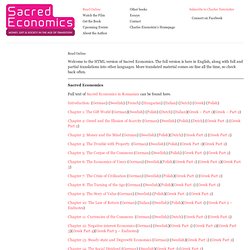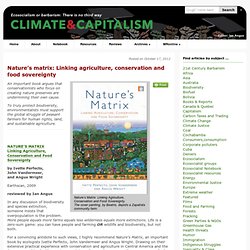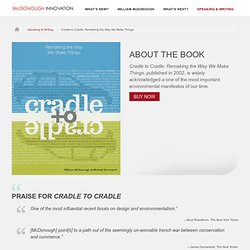

Flanneryogonner.tumblr.com/post/40237682151/free-pdf-books-on-race-gender-sexuality-class. Biblioteca online completa sobre permacultura, bioconstrucción, agricultura ecológica y más. Apreciados lectores, Parece un contrasentido, crear un método en la Apicultura del “no hacer” (Wu Wei, como lo denominó su creador), cuando precisamente esta “cultura” estudia a las abejas, que conforman uno de los modelos asociativos más complejos, organizadas y trabajadoras que se conocen de los seres vivos.

Sin embargo, si juntamos las técnicas… En "CSA ENTRANSICIÓN 2.0" Qué es la permacultura y cómo podemos aplicarla La permacultura es una respuesta que entrega herramientas factibles a nivel individual y colectivo, a la inquietud interna de cada ser humano, por querer conectarnos con la tierra. Por vivir una vida mas ecológica y consciente con nuestro entorno. En "Permacultura" From Dictatorship to Democracy. First the Seed. The Political Economy of Plant Biotechnology Jack Ralph Kloppenburg, Jr.

Publication Year: 2004 First the Seed spotlights the history of plant breeding and shows how efforts to control the seed have shaped the emergence of the agricultural biotechnology industry. This second edition of a classic work in the political economy of science includes an extensive, new chapter updating the analysis to include the most recent developments in the struggle over the direction of crop genetic engineering.
Beyond Growth: The Economics of Sustainable Development - Herman E. Daly - Google Books. Charles Eisenstein. Subscribe to Charles Newsletter Connect on Facebook Read Online Welcome to the HTML version of Sacred Economics.

The full version is here in English, along with full and partial translations into other languages. More translated material comes on-line all the time, so check back often. Sacred Economics Full text of Sacred Economics in Romanian can be found here. Introduction: (German) (Swedish) (French) (Hungarian) (Italian) (Dutch) (Greek) (Polish) Chapter 1: The Gift World (German)(Swedish) (Polish) (Dutch) (Italian)(Greek – Part 1)(Greek – Part 2) Silent Spring. Silent Spring is an environmental science book written by Rachel Carson and published by Houghton Mifflin on September 27, 1962.[1] The book documented the detrimental effects on the environment—particularly on birds—of the indiscriminate use of pesticides. Carson accused the chemical industry of spreading disinformation and public officials of accepting industry claims unquestioningly. In the late 1950s, Carson turned her attention to conservation, especially environmental problems that she believed were caused by synthetic pesticides.
The result was Silent Spring (1962), which brought environmental concerns to the American public. Silent Spring was met with fierce opposition by chemical companies, but it spurred a reversal in national pesticide policy, led to a nationwide ban on DDT for agricultural uses,[2] and inspired an environmental movement that led to the creation of the U.S. Environmental Protection Agency.[3][4] Research and writing[edit] Content[edit] How ‘Silent Spring’ Ignited the Environmental Movement. Nature’s matrix: Linking agriculture, conservation and food sovereignty. An important book argues that conservationists who focus on creating nature preserves are undermining their own cause.

To truly protect biodiversity, environmentalists must support the global struggle of peasant farmers for human rights, land, and sustainable agriculture. NATURE’S MATRIX Linking Agriculture, Conservation and Food Sovereignty by Ivette Perfecto,John Vandermeer,and Angus Wright Earthscan, 2009 reviewed by Ian Angus In any discussion of biodiversity and species extinction, someone insists that overpopulation is the problem. For a convincing antidote to such views, I highly recommend Nature’s Matrix, an important book by ecologists Ivette Perfecto, John Vandermeer and Angus Wright. The issue is not how many people there are, but what the people do: some forms of agriculture destroy life, others preserve and expand it.
A doomed strategy “On the reserves purchased through donations to the Trust, which are expertly managed by its overseas partners, permanent protection is in place. Pedagogy of the Oppressed. Evaluation + Tools + Best Practices. The One-Straw Revolution. Masanobu Fukuoka (1913-2008) was a farmer and philosopher who was born and raised on the Japanese island of Shikoku.

He studied plant pathology and spent several years working as a customs inspector in Yokohama. While working there, at the age of 25, he had an inspiration that changed his life. He decided to quit his job, return to his home village and put his ideas into practice by applying them to agriculture. Over the next 65 years he worked to develop a system of natural farming that demonstrated the insight he was given as a young man, believing that it could be of great benefit to the world.
He did not plow his fields, used no agricultural chemicals or prepared fertilizers, did not flood his rice fields as farmers have done in Asia for centuries, and yet his yields equaled or surpassed the most productive farms in Japan. Cradle to Cradle: Remaking the Way We Make Things. One of the most influential recent books on design and environmentalism.”

—Alice Rawsthorn, The New York Times [McDonough] point[s] to a path out of the seemingly un-winnable trench war between conservation and commerce.”